Some boats whisper ‘take me fishing’ but the Jopalo 5.6m Mr Marlin plate alloy centre console really bellows out the command; it’s built perfectly for nothing else but heading offshore and catching solid fish – so we did.
Yamba Bait and Tackle store owner Dave Gaden owns the glossy black Mr Marlin 5.6 that attracted so much attention at the Sydney Fishing and 4WD Show last June and when he suggested we head out to a trawler wreck in 40 fathoms to jig for kings and bottom fish, I leapt at the opportunity.
The 90hp Suzuki purred onto the plane imperceptibly as we headed across to pick up Dave’s mate Paul before shooting over a placid bar into about 1.5m of easterly swell. We covered the 14 miles in a tad over 35 minutes at 4000rpm and, once or twice when we hit swells with no backs on them, we were briefly airborne and landed gently stern-first. Initially it was a little strange to be riding to starboard at Dave’s custom left-hand-drive console (‘I steer my car with my right hand and shift with my left, so why not my boat?’) but the upholstered seat box was comfy to lean against and there were handholds everywhere.
Dave and Paul are big specimens but we had heaps of room to work around each other as we dropped our jigs and laid into a steady succession of rat kings, flathead and a lovely 4kg pearl perch. As the best boats do, the Jopalo just let us get on with fishing.
Even when we landed the results of a triple hook-up on the same side of the boat, there was no dangerous teetering and it wasn’t until we had the kings aboard that I’d realised we all had been along the port gunwale – nice.
Every time we changed jigs or re-rigged there was a rod holder within reach and even long handles on big threadlines didn’t bang on the rail or gunwale. There are five holders with locking pins along each gunwale cap, another two on the bait board and two at the console set for the appropriate trolling angle.
Dave stores his fish in a large poly esky against the aft end of the seat box but he could have ordered optional insulation in the seat box, it looks well over 150L. Dave had asked Jopalo’s George Lousick to nudge the console slightly forward of normal and George had obliged.
Gunwale height is secure for any fisho, the full-length hand rail is unobtrusive but always there and the level carpeted cockpit didn’t admit water back through the scuppers, even with all occupants at the transom. Dry floor, another tick.
The overboard drain tube on the bait board is typical of the Jopalo attention to detail; drain holes and scuppers are neatly finished with welded clam covers and neat boarding steps are inset into the transom – the more you look, the more pleasant surprises there are. The overall impression is that this boat is built to get on with practical fishing and that’s not surprising because George fishes at every opportunity and knows what he’s doing.
The carpet-lined anchor well has twin drains, swallows 200m of 14mm rope and a reef pick and all anchoring hardware is logically placed.
In this age of injected outboards demanding high-quality fuel, George keeps his tanks above the sealed decks where any contamination from the bowser can be quickly addressed. Dave’s boat had the 110L tank right behind the storage shelves aft of the anchor well bulkhead and there were five standard vertical rod holders inset on each side of the short casting platform.
Because Dave had asked for the console to be further forward it was a tight squeeze going up around the console when 10 rods were stowed there but the rods are safe and dry. Under-gunwale rod racks or, better still, the optional alloy T-top with rocket-launcher, are other ways George can provide rod storage.
Dave opened up the Suzi to 4800rpm for a sweet and economical 27 knots to have us slicing through the bar’s pressure waves on the outgoing tide within 20 minutes. The only bruises I came away with were from battling tough fish without a rod bucket. When I think of how often I’ve come home from an offshore trip with a collection of bumps and bruises from hard edges and protrusions, that’s another plus.
Back in the river I took the wheel and was surprised how easily I adapted to the left-hand drive. The boat rose easily onto a clean plane at 3000rpm with absolutely no transom squat and full throttle made 32 knots GPS at 5400rpm. Dave said fuel consumption was quite miserly, especially at that sweet offshore cruise of 24 to 27 knots.
All the performance numbers indicate the Suzi 90 was an excellent match for the hull and the maximum 140hp would make this boat a projectile more suited to towing barefoot skiers or carrying massive pro loads offshore.
Handling through the standard Sea Star hydraulic steering was totally responsive and even running into a turn at speed, pulling back the throttle, full helm lock, full power and straightening up failed to produce a hint of prop ventilation. If that couldn’t do it, nothing will.
I helped wash down the rig back at Dave’s place, giving me a chance to go over everything in detail. As we hosed down I marvelled at George’s brilliant black exterior paint job – as good as or better than any finish I’ve seen on a plate boat and I’ve seen a few flash ones. The biggest trouble I had was photographing the hull from the side without getting my reflection in the shot!
Water drained from the interior and exterior; there was no puddling anywhere and gobs of dried fish blood just disappeared under the hose jet and the rig was back in boat-show condition in a few minutes.
Then Dave showed me another of George’s customising miracles: He folded the console top forward and the whole rig disappeared into the garage with around 25mm clearance – exactly the amount George had calculated.
I then visited George at his nearby factory and checked out other Jopalos under construction or complete. He builds his vee hulls from 4.5m to 6.5m, mostly with 15° transom deadrise and all with 80mm planing strakes and 60° reverse chines for stability. The self-draining floors are sealed 3mm plate; frames, superstructure and gunwales are 4mm and stringers are 6mm. All hulls feature certificated level foam flotation.
Beam and freeboard can be adjusted to customers’ needs. Construction time is six to eight weeks and on delivery the owner receives a CD of images of the boat during construction, together with a five-year warranty on the hull.
All welding is of an incredibly high standard – there were no bulges or weld dimples where plate ran over frames or ribs, even on the raw alloy finish on a vessel being built for a local pro fisher; there’s very little bog in these boats. The word meticulous springs to mind and applies to everything from fabrication to that brilliant paint finish.
If you’re in the market for the plate boat of your dreams at a very attractive price, you’ll kick yourself if you don’t check out a Jopalo. These are boats of the absolute highest quality, performance and practicality and each vessel is crafted by a very clever bloke who’s probably Australia’s only Aboriginal alloy boat builder.
Length overall5.75m
Hull length 5.6m
Beam2.25m
Side alloy4mm plate
Bottom alloy 4mm plate
Transom deadrise15°
Power 80-140hp
Hull weight950kg
Occupants4 offshore, 6 sheltered waters
FlotationFoam, level
Price as tested on braked SeaLink trailer and 90hp Suzuki: $42,000.
Standard fittings: Bow roller, bollard, drained and carpeted anchor well, forward console seat box, fold-down console screen, 110L above-deck fuel tank with filter, rod holders in casting platform, carpeted console lockers, in-console alloy battery storage with isolator switch and dual maintenance-free batteries, upholstered seat/storage box, self-draining and carpeted sealed cockpit, transom storage lockers, 60L live bait tank with raw-water pickup and pump, flush-mounted transom boarding steps, adjustable transducer bracket, bait board with rod holders and storage box, full-length high or low rails, navigation lights, under-gunwale fluorescent lights, six-gang switch panel, bilge pump with float switch, 27MHz or VHF radio.
Options: Berley bucket, hardtop with rocket launchers, insulated seat box, removable trolling rod holders, removable snapper rod racks, deck wash pump, half- or full-length side pockets, four-gang switch panel with 12V power socket, choice of Koden or Furuno electronics. Other trailer options include suitable models from Swiftco and Dunbier.
Reads: 7368
There’s tackle storage behind the sliding door under the bait board and heaps more storage in the transom – batteries are under the console. The centre plumbed live-bait tank is 60L.

With a paint job such as this, it’s easy to picture yourself in a Jopalo.
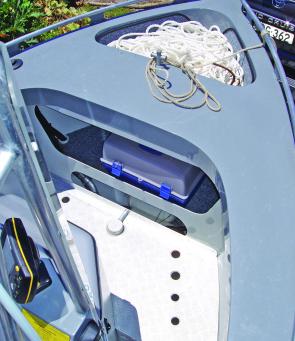
There’s 200m of 14mm rope in the twin-drained and carpeted anchor well, more storage behind and five rod holders either side of the 110L above-deck fuel tank.
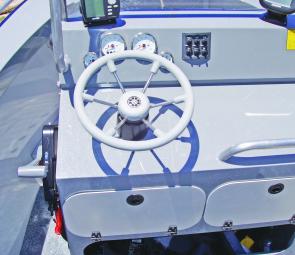
The owner’s custom left-hand helm set-up is easy to get used to and instruments and controls are all placed well. The console top and screen fold forward to allow garage access and expose immaculate wiring for electrics and instruments.

Layout is very functional with storage behind the anchor well, under the high console forward seat, in the console, the seat bin and transom lockers. Side pockets of various lengths are optional.
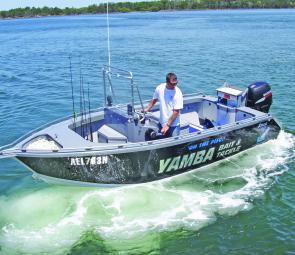
Handling is predictable and easy at all speeds. Check out the water reflections on that brilliant hull paint job.
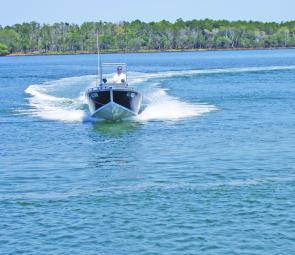
The efficient bow entry runs back to a 15° transom deadrise for a comfortable ride in just about any fishable sea.
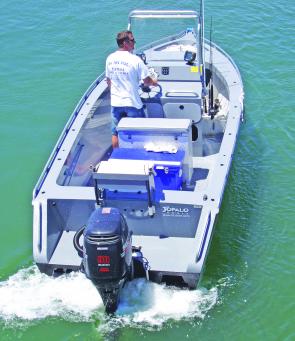
There’s plenty of room to fish three offshore in comfort and safety. The Suzuki 90hp is a fine match, providing economy and performance.
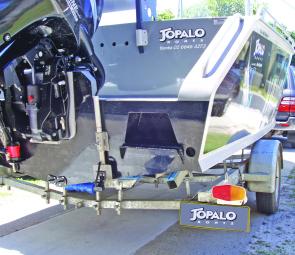
The boarding steps inset in the transom are a clever touch typical of the thought and attention to detail obvious throughout the boat.
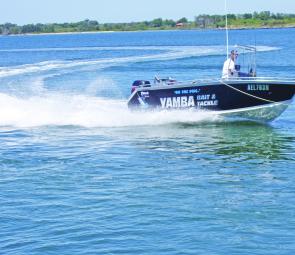
The Jopalo 5.6m Mr Marlin is every inch a thoroughbred, with a delightful blend of performance, fit-up, finish and fishing functionality equal to or better than any builder in the country.




